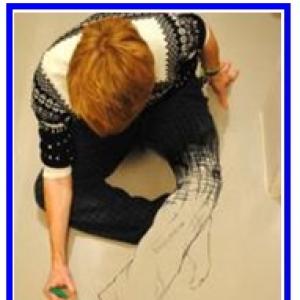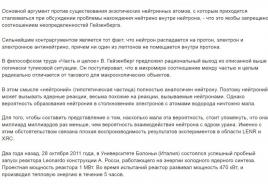One step two step handout. The program for the development of elementary mathematical representations of preschoolers "One - a step, two - a step" work program on the topic
Toolkit on the development of mathematical representations of children 5-6 and 6-7 years old is part of the continuous mathematics course "School 2000 ...". Includes a brief description of the concept, program and organization practical training with kids. Additional materials for the organization of individual work with children are contained in notebooks on a printed basis "One - a step, two - a step ... *, parts 1-2, by the same authors. The educational-methodical set "One - a step, two - a step ..." is focused on the development of thinking, creative abilities of children, their interest in mathematics. Preparatory work with children 3-4 and 4-5 years old can be carried out according to the set "Play", parts 1-2, authors L. G. Peterson and E. E. Kochemasova, and a continuation for elementary school students is the course of mathematics L. G. Peterson. The manual can be used in classes with preschoolers in kindergartens, institutions " elementary School - kindergarten»And other preschool educational institutions, as well as for individual work of parents with children.
Program for the development of mathematical representations "One is a step, two is a step ...".
General concepts
Properties of objects: color, shape, size, material, etc. Comparison of objects by color, shape, size, material.
Collections (groups) of objects or figures that have a common feature. Compilation of a set for a given criterion. Allocation of a part of the population.
Comparison of two sets (groups) of objects. Notation of relations of equality and inequality.
Establishing the equality of two sets (groups) of objects using pairing (equal - not equal, more by ... - less by ...).
Formation of general ideas about addition as the unification of groups of objects into one whole. Formation of general ideas about subtraction as removing a part of objects from the whole. The relationship between the whole and the part.
Initial concepts of quantities: length, mass of objects, volume of liquid and bulk substances. Measurement of quantities using conventional measures (segment, cell, glass, etc.).
Natural number as a result of counting and measuring. Numerical segment.
Drawing up patterns. Search for violation of the pattern.
Working with tables. Acquaintance with symbols.
Content.
Introduction.
Program for the development of mathematical representations.
"One is a step, two is a step ..." (64 lessons).
"One is a step, two is a step ..." (64 lessons).
Approximate thematic planning for the program.
"One is a step, two is a step ..." (86 lessons).
Part 1.
Part 2.
Free download the e-book in a convenient format, watch and read:
Download the book One step, two steps ..., Practical course of mathematics for preschoolers, Methodological recommendations, Peterson L.G., Holina N.P., 2016 - fileskachat.com, fast and free download.
Download djvu
Below you can buy this book at the best discounted price with delivery throughout Russia.
Annotation: A methodological manual for the development of mathematical concepts of children 5-6 and 6-7 years old is part of the continuous course of mathematics "School 2000 ...". Includes a brief description of the concept, program and organization of practical activities with children. Additional materials for organizing individual work with children are contained in notebooks on a printed basis "One - a step, two - a step ...", parts 1-2, by the same authors.
The educational and methodological set "One - a step, two - a step ..." is focused on the development of thinking, creative abilities of children, their interest in mathematics. Preparatory work with children 3-4 and 4-5 years old can be carried out according to the set "Play", parts 1-2, authors L. G. Peterson and E. E. Kochemasova, and the continuation for primary school students is the course of mathematics L. G. Peterson.
The manual can be used in classes with preschoolers in kindergartens, institutions "Primary school - kindergarten" and other preschool educational institutions, as well as for individual work of parents with children.
Download in pdf (119 MB):
Peterson L. G., Kholina N. P. / One is a step, two is a step ... A practical course in mathematics for preschoolers. Guidelines.
Title: One - a step, two - a step ... Mathematics for children and their parents in 2 parts. Part
| --- Volina V.V. - Number holiday. Entertaining mathematics for children - 1993.pdf | --- MATHEMATICS _Encyclopedia For children.pdf | --- Natalya Tomilina _I know the world (for
Title: Speech therapy encyclopedia for parents of preschoolers and younger students
Title: Learning by playing. Mathematics for kids Author: Kuznetsova E. Abstract: This book was written for kindergarten teachers, for teachers of mathematics in
Name: Workbook for speech therapist
Municipal budgetary educational institution "Lyceum No. 35"
Director of MBOU "Lyceum No. _" to work as pedagogical
Lyceum Council No.
Order No. 211 Minutes No. 8
The program was discussed at methodological association teachers primary grades
Protocol No. 1
Program
to prepare preschoolers for the study of mathematics
"First steps in mathematics"
Program compilers:
primary school teachers MBOU "Lyceum No. _":
Lonshakova N.V.
Novokuznetsk district, 2016
This program for the preparation of preschoolers for the study of mathematics is compiled in accordance with the requirements of the Federal State educational standard primary general education, the main educational program of the Lyceum on the basis of the state program for the development of mathematical concepts "One is a step, two is a step ..." proposed by L.G. Peterson and N.P. Choline for preschool preparationand in accordance with the regulations for the preparation, coordination, and approval of programs extracurricular activities (order for MBOU "Lyceum No. 35" dated August 26, 2016 No. 211).
The program is designed for 74 hours, designed for 5 months of training.
This program aims todevelopment of the child's personality: the development of his cognitive interests, intellectual and creative powers preschoolers. When developing the program, the guidelines of the main educational program primary general education MBOU "Lyceum No. 35".
The novelty of this program lies in the activity-based approach to the upbringing and development of the child, in the principle of interdisciplinary integration.
Relevance and the practical significance of the program lies in developing the ability to purposefully master volitional efforts, to establish correct relationships with peers and adults, to see oneself through the eyes of others.
Maintarget programs -formationmotivation of learning, focused on the satisfaction of cognitive interests, the joy of creativity, the development of figurative and variable thinking, imagination, creative abilities.
The objectives of this program:
the formation of motivation for learning, orientation to the satisfaction of cognitive interests, the joy of creativity.
increase in attention and memory.
the formation of mental operations (analysis, synthesis, comparison, generalization, classification, analogy).
development of figurative and variable thinking, fantasy, imagination, creativity.
development of speech, the ability to argue their statements, build the simplest conclusions.
developing the ability to purposefully master volitional efforts, establish correct relationships with peers and adults, see yourself through the eyes of others.
the formation of skills to plan their actions, implement a decision in accordance with the set rules and algorithms, check the result of their actions.
A distinctive feature of the program is the adaptation of children in the transition to a new level of education.
Classes in the program involve variousforms and methods organization of classes:
Practical
Verbal
Gaming
Educational and game
The content of the children's education program corresponds to the level of preschool education, has a scientific orientation and is built on the basis of a system of didacticprinciples :
The principle of psychological comfort. An educational environment is created that ensures the removal of stress-forming factors of the educational process.
The principle of activity. New knowledge is introduced not ready-made, but through an independent "discovery".
The minimax principle. This enables children to learn at different levels.
The principle of a holistic view of the world. With the introduction of new knowledge, its relationship with objects and phenomena of the surrounding world is revealed.
The principle of continuity. Provides continuity between all levels of learning.
These principles reflect modern views on the basis of the organization of developmental education. They not only provide a solution to the problems of intellectual and personal development of students, the formation of their cognitive interests and creative thinking, but also contribute to the preservation and maintenance of their health.
Planned results of mastering the program for the preparation of preschoolers
By the end of training it is supposed to promote children in the development of thinking, speech, mental functions, the formation of their cognitive interests, communication skills and creative abilities.
Students should have an idea of:
On the use of a numerical segment for counting and counting one or more units;
About measuring the length of objects directly and using a measure;
About the arrangement of objects in the order of increasing and the order of decreasing their length, width, height;
ABOUT geometric shapes: square, triangle, circle, rectangle, polygon, parallelepiped, cylinder, cone, pyramid;
About the simplest cases of splitting a figure into several parts, composing whole figures from their parts.
Know:
Parts of a day, a sequence of days in a week, a sequence of months in a year;
For each number within 10, the previous and subsequent numbers;
Composition of the first ten numbers;
Signs\u003e,<, = для записи сравнения;
Signs +, -, \u003d to record addition and subtraction;
Generally accepted units of measurement of quantities: centimeter, liter, kilogram.
Be able to:
To highlight and express in speech signs of similarities and differences of individual objects and aggregates;
Combine groups of objects, highlight a part, establish a relationship between a part and a whole;
Find parts of a whole and a whole by known parts;
Compare numbers within 10 using visual aids;
Correlate the figure with the number of items;
Express in words the location of the object, navigate on a sheet of checkered paper (top, bottom, right, left, middle);
Continue a given pattern with 1-2 changing signs, find a violation of the pattern;
Perform addition and subtraction of numbers within 10 based on subject actions;
Directly compare objects by length, weight.
In this case, the following forms in childrenbasic skills:
Basic skills are given at two levels:
Level A - the planned minimum of education; level B is the desired level.
1) Ability to compare, based on clarity, adjacent numbers within 10.
2) Ability to name for each number within 10 the previous and subsequent numbers.
3) Ability to determine the composition of the top ten numbers based on objective actions.
4) Ability to correlate the number with the number of items.
5) Ability to measure the length of objects directly and using a measure, arrange objects in increasing order and in decreasing order of their length, width, height.
10) Ability to recognize and name a square, circle, triangle.
6) The ability, in the simplest cases, to break figures into several parts and to compose whole figures from their parts.
7) Ability to express in words the location of an object, to navigate on a sheet of checkered paper (top, bottom, right, left, middle).
8) Ability to name parts of a day, a sequence of days in a week, a sequence of months in a year.
Level A
1) The ability to distinguish and express in speech signs of similarities and differences of individual
objects and aggregates.
2) Ability to combine groups of objects, highlight a part, establish a relationship between a part and a whole.
3) Ability to find parts of a whole and a whole from known parts.
4) The ability to compare groups of objects by quantity using pairing, equalize them in two ways.
Level B
1) The ability to continue a given pattern with 1 - 2 changing signs, to find a violation of the pattern. The ability to independently compose a series containing some regularity.
2) The ability to compare numbers within 10 using visual material and establish how much one number is greater or less than another. Ability to use the signs\u003e,<,=.
3) Ability to perform addition and subtraction of numbers within 10. based on objective actions.
4) Ability to write addition and subtraction using signs;
5) Ability to use a numeric segment to count and count one or more units:
6) Ability to directly compare objects in terms of length, mass, volume (capacity), area;
7) The ability to practically measure the length and volume with various measures (step, elbow, glass, etc.). An idea of \u200b\u200bthe generally accepted units of measurement of these quantities: centimeter, liter, kilogram.
8) The ability, along with a square, a circle and a triangle, to recognize and name a rectangle, polygon, ball, cube, parallelepiped (box), cylinder, cone, pyramid. Find objects similar in shape in the environment.
9) Ability to design more complex shapes from simple ones according to a given pattern.
Thematic plan
p / p
Section name
Number of lessons
General concepts
Numbers and operations on them
Space-time representations
Geometric shapes and sizes
TOTAL:
Content of the program
General concepts (20 hours)
Property of objects: color, shape, size, material, etc. Comparison of objects by color, shape, size, material.
Collections (groups) of objects or figures that have a common feature. Compilation of a set for a given criterion. Allocation of a part of the population.
Comparison of two sets (groups) of objects. Notation of relations of equality and inequality.
Establishing the equality of two sets (groups) of objects by means of pairing (equal - unequal, more by ... - less by ...).
Formation of general ideas about addition as the unification of groups of objects into one whole. Formation of general ideas about subtraction as removing a part of objects from the whole. The relationship between the whole and the part.
Initial ideas about quantities: length, mass.
Numbers and operations on them (24 hours)
Direct and reverse counting within 10. Ordinal and rhythmic counting.
Formation of the next number by adding one. Name, sequence and designation of numbers from 1 to 10 digits, dots on a line segment. Composition of the first ten numbers.
Equality and inequality of numbers. Comparison of numbers (more by ..., less by ...) on a visual basis.
Formation of ideas about addition and subtraction of numbers within 10 (using visual support). The relationship between addition and subtraction of numbers.
Number 0 and its properties.
Solving simple (one-step) addition and subtraction problems using visual material.
Spatio-temporal representations (15 hours)
Examples of relationships: on - above - below, left - right - in the middle, front - back, top - bottom.
Orientation on a sheet of paper in a cage.
Geometric shapes and sizes (15 hours)
Formation of the ability to select objects of the same shape in the environment. Acquaintance with geometric shapes: square, rectangle, triangle, quadrilateral, circle, ball.
Formation of ideas about a point, straight line, ray, segment, broken line, polygon, angles, about equal figures, closed and open lines.
Educational-methodical teaching aids
L.G. Peterson, N.P. Choline. One - a step, two - a step ... A practical course in mathematics for preschoolers. Guidelines. Ed. 3rd, additional and revised - M .: Publishing house "Juventa", 2008.
L.G. Peterson, N.P. Choline. One - a step, two - a step ... Mathematics for preschoolers (parts 1, 2). ("School 2000 ...").
"School 2000 ...". Mathematics for everyone: concept, programs, work experience / Ed. G.V. Dorofeeva. - M .: UMC "School 2000 ...", 2000.
Electronic resources
1. Big children's encyclopedia for children. [Electronic resource] (09.03.11)
Appendix 1
Calendar-thematic plan
Item properties: materialGrouping items
We group objects, designate a sign
Search for patterns
Search for patterns. Tables
Comparison of groups of subjects
Equality and inequality notation.
Relationship: part-whole.
Understanding the action of addition
Spatial relationships: on, above, below.
Spatial relationships: left, right.
Spatial relationships: on, above, below, left, right.
Removing a part from a whole
Understanding the action of subtraction
Spatial relationship between, in the middle
The relationship between the whole and the part.
Performance: one - many.
Number 1 and number 1.
Spatial relationships inside, outside
Number 2 and number 2.
Number 2 and number 2. Pair.
Point and line concept.
Segment, beam
Number 3 and number 3.
Number 3 and number 3.
The concept of closed and open lines.
Broken line. Polygon.
Number 4. Number 4.
The score is 1-4. Number 4
Understanding of angles and types of angles.
The concept of a numerical segment.
Number 5. Number 5.
Coins. Pyatak. Number 5
Spatial relationships in front, behind
Comparison of groups of subjects
Relationship designation: more - less.
Time-space relationships earlier, later
Temporary relationship: earlier, later.
Number 6. Number 6
The score is 1-6. Number 6
Time-space relationships are longer, shorter
Quantities and their measurement
Length. Length measurement
Number 7. Number 7.
Quantity and count. Score 1-7
Search for patterns
Relationships: Harder, Lighter.
Comparison of mass.
Mass measurement
Walk in the garden. Quantity and count.
Number 8. Number 8.
Quantity and count. The score is 1-8.
Quantity and count. Number 8.
Volume concept.
Comparison by volume.
Volume measurement
Quantity and count.
Number 9. Number 9.
Quantity and count. Score 1-9
The idea of \u200b\u200bthe square. Area comparison.
Area measurement
Number 0. Number 0.
Number 0. Number 0.
Number 10.
Number 10.
The concept of addition and subtraction within 10.
Addition and subtraction within 10.
Volumetric objects around us. Ball. Cube. Parallelepiped
Volumetric objects around us. Pyramid. Cone. Cylinder
Symbols
Reiteration
Play-ball-step to school. Practical course of mathematics for preschoolers. Guidelines. Part 4 (1-2). Peterson L.G., Kochemasova E.E.
M .: 20 1 4 - 320 p.
The educational-methodical manual "Playful - a step to school" for the development of mathematical representations of children 6-7 years old is the initial link in the continuous course of mathematics "School 2000 ...". Contains a brief description of the concept, program and conduct of classes with children in accordance with the new requirements for the organization of classes on the didactic system of the activity method "School 2000 ..." (Prize of the President of the Russian Federation in the field of education for 2002). Additional materials to this manual for the organization of individual work with children are contained in notebooks with a printed basis "Playful - a step to school", part 4 (1-2), by the same authors. The educational and methodological set "Playful - a step to school" is focused on the development of thinking, creative abilities of children, their cognitive activity and interest in mathematics. The continuation of this educational-methodical set is the set "One-step, two-step ..." by L. G. Petersoni N. P. Kholina for elementary school students - the mathematics course L. G. Peterson. The manual can be used in classes with preschoolers in kindergartens, institutions "Primary school - kindergarten" and other preschool educational institutions, as well as for individual work of parents with children.
Format: pdf
The size: 46 MB
Watch, download:drive.google
Content
Introduction 3
Program-course "Playful - a step to school", parts 3-4 for children 5-6 years old and 6-7 years old 7
Approximate thematic planning "Play - a step to school", part 4.
The fourth year of study (6-7 years, preparatory group for school) 10
Methodological support of the course of mathematics "Play-a-step to school", part 4 11
Lesson 1. TOPIC: Review 14
Lesson 2. TOPIC: Review 19
Lesson 3. TOPIC: Review 25
Lesson 4. TOPIC: Review 32
Lesson 5. TOPIC: Number and number 1 38
Lesson 6. TOPIC: Number and figure 2 45
Lesson 7. TOPIC: Number З 53
Lesson 8. THEME: Number and digit З 60
Lesson 9. TOPIC: Numbers and numbers 1-3 67
Lesson 10. TOPIC: Numbers and numbers 1 - 3 72
Lesson 11. TOPIC: Point. Line. Straight and curved lines 79
Lesson 12. THEME: Ray. Line 87
Lesson 13. TOPIC: Open and closed lines 94
Lesson 14. TOPIC: Broken line. Polygon 101
Lesson 15. TOPIC: Number 4 106
Lesson 16. TOPIC: Number and number 4 112
Lesson 17. Topic: Number and number4 119
Lesson 18. TOPIC: Number segment 119
Lesson 19. TOPIC: Number segment 125
Lesson 20. TOPIC: Left, Right 130
Lesson 21. TOPIC: Spatial relationships 136
Lesson 22. TOPIC: Number 5 136
Lesson 23. TOPIC: Number and digit 5 \u200b\u200b142
Lesson 24. TOPIC: Number and digit 5 \u200b\u200b148
Lesson 25. TOPIC: Numbers and numbers 1-5 153
Lesson 26. TOPIC: More, less 157
Lesson 27. TOPIC: Inside, outside 163
Lesson 28. TOPIC: Number 6 169
Lesson 29. TOPIC: Number and digits 174
Lesson 30. TOPIC: Number and figure 6 181
Lesson 31. TOPIC: Review 188
Lesson 32. TOPIC: Review 188
Lesson ЗЗ. TOPIC: Number 7 188
Lesson 34. TOPIC: Number and number 7 193
Lesson 35. TOPIC: Number and digit 7 199
Lesson 36. TOPIC: Numbers and numbers 6-7 203
Lesson 37. TOPIC: Earlier, later 207
Lesson 38. TOPIC: Measurement of volume 212
Lesson 39. TOPIC: Measurement of volume 218
Lesson 40. TOPIC: Number and digit 8 222
Lesson 41. TOPIC: Number and number 8 228
Lesson 42. TOPIC: Numbers and numbers 6,7,8 233
Lesson 43. TOPIC: Number and number E 237
Lesson 44. TOPIC: Number and number E 243
Lesson 45. TOPIC: Measuring area 249
Lesson 46. TOPIC: Number and number O 255
Lesson 47. TOPIC: Number and digit 0 262
Lesson 48. TOPIC: Measuring length 267
Lesson 49. TOPIC: Review 272
Lesson 50. TOPIC: Measurement of length 272
Lesson 51. TOPIC: Measuring length 278
Lesson 52. TOPIC: Number 10 285
Lesson 53. TOPIC: Number 10 291
Lesson 54. TOPIC: Comparison by mass 296
Lesson 55. TOPIC: Measuring mass 301
Lesson 56. TOPIC: Measuring mass 307
Lesson 57. TOPIC: Clock 312
Sessions 17,21,31,32,34,58-64. TOPIC: Review 317







